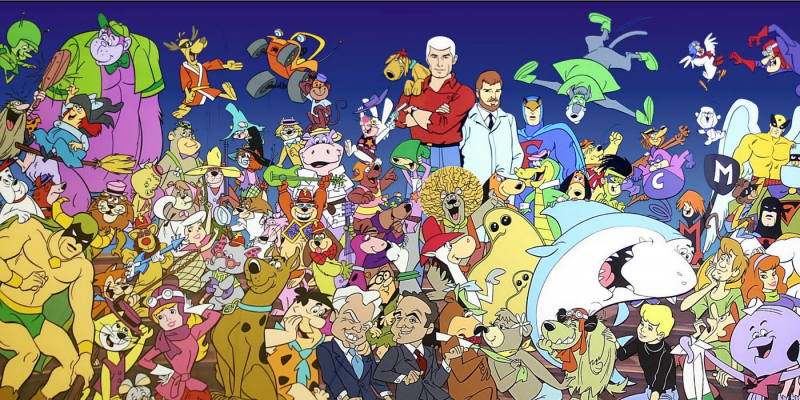Top 10 Things You Never Realized About Popular Cartoons
Modern animation has roots in the phenakistoscope, a device invented in the 1830s that projected images onto a rotating cardboard disk to give the appearance ... read more...of movement. Since it's practically impossible to calculate, there aren't even data on the number of animated cartoons that have been produced to date. They are created by everyone working at large studios like Walt Disney and Warner Bros., as well as by individuals using computers at home. The more you look into them, the more incredible behind-the-scenes information you might uncover that becomes even more contentious.
-
Betty Boop is a well-known cartoon character if you even have a passing knowledge of them. She had a distinct, high-pitched voice and was supposed to look like a flapper in the 1930s. Nearly a century later, the character is still widely recognized as one of the first animated sex icons. Many people are unaware that Helen Kane, an actress, sued the creators of Boop for copying her voice and appearance.
I Wanna Be Loved by You, a song that Kane notably performed in 1928 and Betty Boop later made even more well-known. Even the character's creator, Max Fleischer, acknowledged that he based Boop in part on Kane. Kane had developed a distinctive vocal style that was simultaneously provocative and almost like baby talk.
Kane filed a lawsuit against the studio in 1932 accusing them of ripping off her appearance and voice, and so far, the case is all but over. However, you've never heard of Baby Esther. Before Helen Kane, who performed under the moniker Baby Esther, there was Esther Jones. There is proof that Kane saw Jones perform in the late 1920s, before she became well-known herself. She performed music at the Cotton Club in Harlem and had developed a persona that combined those silly "boop" and "doop" noises with a sensuous stage presence.Kane was effectively suing for an act she herself had stolen, and video footage of previous Baby Esther performances was used to disprove her claim that she was the original performer. Kane lost her court case. Sadly, Baby Esther was no longer alive at that point and was assumed to have died, thus she was never able to take on the role of Betty Boop's "true" face.

https://aminoapps.com/ 
https://jeovannypaz.wordpress.com -
Clone High made its debut in the early 2000s, first in Canada and subsequently on MTV. The mature cartoon showed a high school where every pupil was a replica of a famous historical figure. All is well thus far. However, it was called off soon after large-scale, extremely serious protests in India were staged, leading to the hunger strikes of 100 people, including officials from the Indian government.
MTV instantly apologized and informed the show's creator that it was finished. To be safe, they even removed any references to the show from their website. But why would a cartoon make such a stir? particularly in a nation where the program didn't even air? Gandhi.
Gandhi appeared as a character on the show, but the writers decided to make him a party animal who was obsessed with getting wasted and having sex rather than a true representation of the man Gandhi was in real life. As you might imagine, this was not well received in the country where he is regarded as a national hero.

https://www.sub-talk.net/ 
https://aminoapps.com/ -
Cross-promotion of films is nothing new; virtually every major summer blockbuster has a fast food tie-in at a major restaurant chain. For the final three films in the series, they even offered salad in bags with Star Wars logos. In light of this, Disney's attempt to collaborate with Costco in 2007 to promote the film Ratatouille wasn't absurd.
What the two businesses decided to do in this situation was the issue with the relationship. They made wine with the Ratatouille logo. It wasn't crazy because the movie was about a rat chef. However, it was against the 1949-established Wine Institute advertising standards.
The entire idea was against wine advertising regulations even though there were 500 cases of chardonnay available to be sold as cartoon rat wine. A cartoon rat from a blockbuster animated film is hardly more enticing to children than plastering it on a label, yet their rule forbids any advertising that could be seen as appealing to children. Despite the fact that the winery was French and not subject to the regulations that are exclusive to California, the plan had to be abandoned.

https://unsplash.com 
https://www.travelandleisure.com -
The adage "knowledge is half the battle" is probably well known to everyone who grew up in the 1980s. This was the way every 30-second PSA that was slapped into an episode ended, made popular by GI Joe. Why would a PSA take up 30 seconds of valuable cartoon airtime? Strategy. Like He-Man and Transformers, GI Joe was essentially a 30-minute action figure advertisement.
It was made to sell toys, and in order to do so, it capitalized on the joy of destroying your adversaries. The creators of the show made it “educational” to head off critics, since they were aware that may be a problem in ways we addressed with the ThunderCats. A small PSA was added to add value to the program. This went above and beyond simply having a doctor on staff. Now that the show's significance was clear,
The PSAs were reviewed by the National Child Safety Council and were overseen by a physician from Harvard's School of Education and Human Development. The Children's Television Act of the 1990s, which obliged TV stations to guarantee that a certain percentage of children's programming was, in fact, educational, could be made to link this to the overall attitude of TV critics at the time. Shortly after, channels requesting for broadcast license renewals identified GI Joe as instructional programming, possibly taking advantage of this exact regulation.
https://www.behance.net/ Retro Galaxy Unlimited channel on Youtube -
Casey Kasem, who created the first voice of America's Top 40, also created the original Shaggy voice from Scooby-Doo. He began portraying Shaggy in the 1960s and continued performing voices up until a few years before his passing in 2010. However, there was a moment when Kasem genuinely left the show in protest.
Between 1995 and 2002, Kasem declined to perform Shaggy's voice since the actors were going to be featured in a Burger King commercial. Kasem, a vegan and ardent supporter of that way of life, was allegedly disappointed that Hanna-Barbera, the animation company that created the program, decided against making Shaggy a vegan as well. To be fair, Shaggy's schtick for years had been that he ate everything and everything with a ravenous hunger.
Kasem not only rejected the advertisement but also completely left the program for seven years. Shaggy only came back when the producers gave in and agreed to make him a vegetarian.
http://www.sunny1031.com 
https://www.ageekdaddy.com/ -
After nearly 70 years, Pepe Le Pew was dropped from the Looney Tunes cast in 2021. It turns out that a cartoon whose only gag is to pursue a woman incessantly who vehemently refuses to be around him before forcing himself on her when he captures her is not really appropriate. Prior to that, however, several individuals did ponder how a cartoon that appears to ruthlessly criticize the French could have persisted for so long. Even so, what did the French think?
It seems that very few French people were unaware of the problem. Pepe Le Pew was Italian in France, not at all French. . In order to make fun of clichés of a different culture and language, actor Francois Tavares performed the French dub of Pepe le Putois, which translates to "polecat," for French audiences.
Mind you, this wasn't done to avoid offending the French. How is it possible? The joke would be destroyed if they encountered a character with a French accent; it wouldn't be at all offensive. Pepe had to adopt a new accent in France otherwise the joke would be lost. They ultimately decided on Italian because he was a seducer and it also fits the sexy stereotype.
https://www.fortressofsolitude.co.za/ 
https://www.animationsensations.com -
The ThunderCats were a close-knit group of feline-like humanoids from the planet Thundera, for those who need a refresher. They escape their fatal planet in a spaceship and arrive on Third Earth, where they start to establish a base of operations. However, trouble quickly arises in paradise because enemies from Thundera have followed them and immediately team up with Mumm-Ra, a legendary tyrant who once ruled Third Earth and is now attempting to do so once more. If you can recall all of that, check your knowledge of ThunderCats against this list of 15 things you probably didn't know.
Think again if you ever believed that 1980s cartoons were nothing more than meaningless entertainment or merely a way to promote action toys! The ThunderCats were even equipped with a psychologist to make sure it happened. If nothing else, their mission was to teach children morality. To analyze all scripts and provide feedback on matters of violence and morality, Dr. Robert Kuisis was hired.
This was done in 1985, a year when media outlets were quite concerned about violence and overt child-targeting in cartoons. Cartoon creators tried to position themselves as having value before a backlash from critics could occur because cartoons were regularly criticized for being either excessively violent or lacking in value for the children who watched them.

https://outloudculture.com/ 
https://www.youtube.com/ -
You may have observed that God has five fingers whereas everyone else in the universe only has four when a character on The Simpsons talks to him. Additionally, you might have observed that for many years, most cartoon characters had four rather than five fingers.
Making a fifth finger in hand drawn animation was laborious in the past, but owing to computers, it is no longer a problem. Additionally, it altered figures' geometry, which was essentially based on a succession of circles. A character like Mickey Mouse would look odd and be more challenging to design if he had more fingers.
Furthermore, many of the early characters didn't actually belong in the human race, therefore they weren't really required to have five fingers. And because it takes more time and effort to make a fifth finger move, animating it really costs more money. According to legend, Walt Disney estimated that utilizing four fingers would save millions of dollars.

https://didyouknowstuff.com 
http://designtaxi.com/ -
It is not simple to create animation, and it used to be lot more difficult. Thousands and thousands of photos, each only slightly different from the one before it in the sequence, had to be combined to create a hand-drawn cartoon. Think about painting Mickey Mouse moving his legs a little bit higher in each drawing as he climbs a flight of stairs 1000 times in a row.
Animators learned to take shortcuts in order to save time and effort. Early Hanna-Barbera cartoons, where it appeared like every single character was wearing a collar and necktie, made one of these quite obvious. Yogi Bear could keep his body still and only need to move his head when he was wearing a tie. This resulted from the smaller finances that cartoonists had to work with when creating content for television. Instead of the normal 14,000 drawings, a cartoon might be produced with as few as 2,000.

http://www.cbr.com/ 
http://bluedreamer27.blogspot.com/ -
The real reason Popeye murmured under his breath is quite straightforward. The animation and voice acting fell short of expectations. The old salty sailor appears to be speaking, but his lips aren't moving, giving the idea that he may be speaking under his breath because the animation was completed before the voice acting was added.
Today's cartoons probably wouldn't get away with this, mainly because the viewers could perceive it as laziness and the effect would be lost on those who have grown up with CGI getting better every year. Even so, there might be a valid explanation for why Popeye hasn't made a comeback. It's possible that his many different mutterings would be challenging to animate or even impossible to replicate because whoever did it would have to at the very least research Jack Mercer's dialogue from the original cartoons to make it sound somewhat genuine.
However, the idea of Popeye might be out of date because, if you recall, he wasn't the most politically correct character ever. Bluto was significantly worse, but he wasn't the worst by a by shot. However, animators don't seem to go for a fist-based approach unless their subjects are inherently physical in nature and are intended more for older children who can distinguish between truth and imagination. You could argue that Popeye was targeted at the same age group, but at this point, at least in kid cartoons, the idea of eating spinach to become a tough guy and then just clobbering the bad guy isn't something that people want to see.

https://gamesdb.launchbox-app.com 
https://pzc1.blogspot.com































